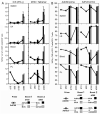Multiple immunizations with adenovirus and MVA vectors improve CD8+ T cell functionality and mucosal homing
- PMID: 17590405
- PMCID: PMC2043483
- DOI: 10.1016/j.virol.2007.05.028
Multiple immunizations with adenovirus and MVA vectors improve CD8+ T cell functionality and mucosal homing
Abstract
Recombinant adenovirus vectors and MVA vectors were used in prime boost vaccine regimens to address the impact of repeated immunizations on transgene product-specific CD8(+) T cell frequencies, phenotypes, function, and localization. We show that a regimen with three immunizations incorporating MVA, human adenovirus serotype 5 and chimpanzee-derived adenoviruses serotype 68 or 7 yields high transgene product-specific CD8(+) T cell frequencies in spleen, blood, lymph nodes, and peritoneal lavage. Furthermore, upon triple immunization increased frequencies of transgene-specific T cells were measured at mucosal sites such as mesenteric lymph nodes, intestinal epithelium, and Peyer's patches. Multiple dose vaccine regimens that markedly increase functionally active transgene-specific T cells and target them to the appropriate ports of entry may be important in protection against pathogens such as HIV-1.
Figures





References
-
- Ahmed R, Gray D. Immunological memory and protective immunity: understanding their relation. Science. 1996;272(5258):54–60. - PubMed
-
- Badovinac VP, Porter BB, Harty JT. Programmed contraction of CD8(+) T cells after infection. Nat Immunol. 2002;3(7):619–26. - PubMed
-
- Casimiro DR, Bett AJ, Fu TM, Davies ME, Tang A, Wilson KA, Chen M, Long R, McKelvey T, Chastain M, Gurunathan S, Tartaglia J, Emini EA, Shiver J. Heterologous human immunodeficiency virus type 1 priming-boosting immunization strategies involving replication-defective adenovirus and poxvirus vaccine vectors. J Virol. 2004;78(20):11434–8. - PMC - PubMed
-
- Casimiro DR, Tang A, Perry HC, Long RS, Chen M, Heidecker GJ, Davies ME, Freed DC, Persaud NV, Dubey S, Smith JG, Havlir D, Richman D, Chastain MA, Simon AJ, Fu TM, Emini EA, Shiver JW. Vaccine-induced immune responses in rodents and nonhuman primates by use of a humanized human immunodeficiency virus type 1 pol gene. J Virol. 2002;76(1):185–94. - PMC - PubMed
-
- Cerwenka A, Morgan TM, Dutton RW. Naive, effector, and memory CD8 T cells in protection against pulmonary influenza virus infection: homing properties rather than initial frequencies are crucial. J Immunol. 1999;163(10):5535–43. - PubMed
Publication types
MeSH terms
Substances
Grants and funding
LinkOut - more resources
Full Text Sources
Other Literature Sources
Research Materials

